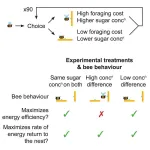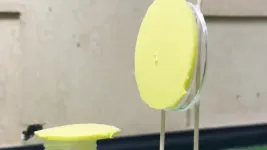(Press-News.org) If you’ve ever watched a bumblebee move from flower to flower, you might wonder how they decide which flower to choose and how long to stay. Now, researchers reporting in the journal iScience on October 24 have new insight based on their observations of bumblebees’ interactions with slippery artificial flowers. They found that the bumblebees make choices to maximize the rate of energy return, or the amount of sugar collected each minute.
“Bumblebees can make decisions ‘on the fly’ about which nectar sources are the most energetically economical,” said Jonathan Pattrick, first author of the study and now based at the University of Oxford, U.K. “By training bumblebees to visit artificial slippery flowers and using different ‘nectars’ with high, medium or low amounts of sugar, we found that they could make a trade-off between the energy content of the nectar and how difficult it was to access.”
In other words, bumblebees choose nectar sources that maximize their immediate return of sugar to the colony, instead of optimizing the energy efficiency of their foraging. That’s different from earlier findings in honeybees, which show that honeybees maximize energy efficiency instead.
“Bumblebees have a different lifestyle to honeybees: they only store a small amount of nectar in the nest and so have to make the most of every available opportunity to forage,” Pattrick said. “This difference between species may be why the bumblebees adopt a strategy such that their foraging is of more immediate benefit to the colony, even if it means they have to work harder, while honeybees take a relatively more measured approach to how hard they work – this should prolong their working lifespan.”
“Identifying the currency used by nectar-foraging bumblebees helps provide a framework for understanding how bumblebees make foraging decisions,” said Pattrick. “This information can be used to make predictions about the sorts of flowers the bees are likely to be visiting. In turn, this could inform choices of the flowers to plant in field margins and is also relevant to crop breeders who want to make varieties which are ‘better’ for bumblebees.”
In work carried out at the University of Cambridge, UK, Pattrick and his colleagues used vertically and horizontally oriented slippery-surfaced artificial flowers to test whether bumblebees could make a trade-off between the difficulty in handling a particular flower and its nectar sugar concentration.
A custom computer program allowed them to measure the split-second timing of bumblebee behavior as they decided whether to collect high-sugar nectar from slippery flowers, which required them to expend energy hovering, or lower-sugar nectar from flowers on which they could land. Overall, they captured 60,000 separate behavioral observations, allowing them to precisely estimate foraging energetics. Earlier studies on bumblebee foraging currencies had been based mainly on watching what bees do naturally, making it difficult to distinguish how their decisions were being made.
The data showed that bumblebees chose flowers that were either hard to handle or had a low concentration of sugar, depending on which was more energetically favorable. Their decisions fit with a model in which their critical currency is the rate of energy return as opposed to energetic efficiency, the researchers report.
The researchers say future work should investigate whether bumblebees consistently use this currency, even when the foraging context changes. They are also fascinated by the insects’ intelligence: “we find it amazing that, even with a relatively simple brain, bumblebees are able to make such complex energetic decisions,” Pattrick says.
###
This work was supported by the Biotechnology and Biological Sciences Research Council.
iScience, Pattrick et al. “Bumblebees negotiate a trade-off between nectar quality and floral biomechanics” https://www.cell.com/iscience/fulltext/S2589-0042(23)02148-X
iScience (@iScience_CP) is an open-access journal from Cell Press that provides a platform for original research and interdisciplinary thinking in the life, physical, and earth sciences. The primary criterion for publication in iScience is a significant contribution to a relevant field combined with robust results and underlying methodology. Visit http://www.cell.com/iscience. To receive Cell Press media alerts, contact press@cell.com.
END
When it comes to the question of who gets to be a scientist, gender disparities are well-documented in many fields. Patching the infamous “leaky pipeline” can be a thorny problem, but during the 2022–2023 school year, the Department of Chemistry at the University of Oxford took a simple and practical step forward: they began offering period products in the department’s bathrooms. In an article publishing October 25 in the journal Trends in Chemistry, three students involved in the Oxford Period Project and their supervising ...
About The Study: In this randomized clinical trial of 3,777 patients with ST-segment elevation myocardial infarction (STEMI; a type of heart attack), the Chinese patent medicine Tongxinluo, as an adjunctive therapy in addition to STEMI guideline-directed treatments, significantly improved both 30-day and 1-year clinical outcomes. Further research is needed to determine the mechanism of action of Tongxinluo in STEMI.
Authors: Yuejin Yang, M.D., Ph.D., and Runlin Gao, M.D., of the Chinese Academy of Medical ...
Research has found that bumblebees make foraging choices to collect the most sugar from flowers in the shortest time – even if that means using more energy in the process – to provide an immediate energy boost for the colony.
A new study investigating nectar drinking in one of the most common bumblebees in the UK, Bombus terrestris, has found that when foraging they maximise the amount of nectar sugar they take back to the colony each minute.
To make their choices, the bumblebees trade off the time they spend collecting nectar with the energy content of that nectar. This means ...
About The Study: In this examination of SARS-CoV-2 incidence and transmission in child care centers (CCCs) and students’ households, transmission within CCCs and from children infected at CCCs into households was low in this study that included 83 children in 11 CCCs. These findings suggest that current testing and exclusion recommendations for SARS-CoV-2 in CCCs should be aligned with those for other respiratory viruses with similar morbidity and greater transmission to households.
Authors: Timothy R. Shope, ...
About The Study: The results of this study of 91,460 mother-offspring pairs found no association between in utero corticosteroid and β2-adrenergic agonist exposure and offspring neurodevelopmental outcomes, regardless of the timing of exposure. Despite the limitations and low power of the study, the findings suggest that corticosteroids and β2-adrenergic agonists are safe for pregnant individuals with asthma and the neurodevelopment of their offspring.
Authors: Abir Nagata, Ph.D., of Osaka University in Osaka, Japan, and Toshio Masumoto, Ph.D., of Tottori University ...
Children in child care centers are not spreading COVID-19 at significant rates to caregivers or other children at the center, nor to their households, according to a study led by University of Pittsburgh School of Medicine and UPMC Children’s Hospital of Pittsburgh pediatrician-scientists and published today in JAMA Network Open.
The findings suggest that recommendations to test symptomatic children for SARS-CoV-2, the virus that causes COVID-19, and keep positive children home from child care for prolonged periods can be revised to align with those for other serious ...
PHILADELPHIA—The Pew Charitable Trusts announced today the six pairs of researchers who will make up its 2023 class of Innovation Fund investigators.
These 12 acclaimed scientists—all alumni or advisors of Pew’s biomedical programs in the United States and Latin America—will partner on interdisciplinary research projects exploring key questions in human biology and disease. Combining the researchers’ expertise in topics ranging from neuroscience and immunology to cancer biology, these collaborations will help boost scientific discovery and improve human health.
“An interdisciplinary approach to research is critical to uncovering scientific breakthroughs ...
Why would someone decide to give their money to help a stranger bring a creative project to life?
Recent research has found that backers of crowdfunding projects participate, in part, because of a sense of indirect success and the feeling that they are contributing to something bigger.
Crowdfunding — raising money for a new venture by collecting small amounts from many people — is most often done online, and messaging on the most popular sites reinforces the perception of a more democratic market.
But the reality is a bit ...
CORVALLIS, Ore. – An international coalition of climate scientists says in a paper published today that the Earth’s vital signs have worsened beyond anything humans have yet seen, to the point that life on the planet is imperiled.
William Ripple, a distinguished professor in the Oregon State University College of Forestry, and former OSU postdoctoral researcher Christopher Wolf are the lead authors of the report, and 10 other U.S. and global scientists are co-authors.
“Without actions ...
In a year marked by wildfire, catastrophic flooding, and deadly weather events, an international team of scientists has updated its influential 2019 World Scientists Warning of a Climate Emergency report, which has been cosigned by over 15,000 scientists representing 163 countries. According to the team, “life on planet Earth is under siege” and “we are now in uncharted territory.”
Writing in the journal BioScience, William Ripple, a distinguished ...







